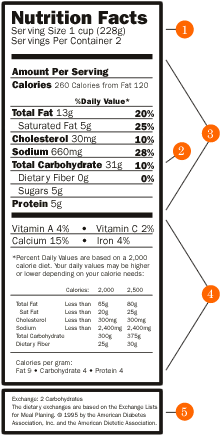A Guide To The Food Label
Some people may be using the nutrition facts on the food label to help determine what foods should or should not be eaten. Instead, think of using the food label as a tool to assist you in determining how to fit any food into your healthy meal plan.
The food label contains the nutrition information or facts about the content of a food item. This information, when understood, will allow for more freedom of choice without the guilt often associated with eating certain foods.
If you learn anything from this guide, let it be that NO FOOD IS TRULY A BAD FOOD! Understand that certain foods, due to their content of fat, carbohydrate and/or protein, cannot be eaten in unlimited amounts, if your goals are to manage your weight and to stay within the guidelines of a healthy meal plan.
How To Read The Food Label
 1. Always look at the serving size first. The nutrient information on the food label is based on one serving of the item.
1. Always look at the serving size first. The nutrient information on the food label is based on one serving of the item.
2. Refer to the item you are interested in counting. The example points to Total Carbohydrate which is 31 grams.
3. Adjust the number according to what you consumed or will eat. In other words, if more than or less than one serving is eaten, you would need to multiply or divide the numbers to
reflect the amount you actually eat.
4. This is the FYI (For Your Information) section of the food label. The information in this section stays constant except for the % Daily Values, i.e., vitamins A and C and the minerals calcium and iron. The % Daily Values for vitamins and minerals in a food item change to reflect the nutrients in that item.
5. The dietary exchanges for a food item may be available on the package. The exchange information is often located separate from the food label, either below the food label, next to the label or on the sides of the packaging. This information can help you to know how this food item fits into your healthy meal plan. For example, there are 2 carbohydrates (also referred to as bread or starch servings), in one serving of this item. Remember, 15 grams of carbohydrate equals 1 carbohydrate or bread serving.

 1. Always look at the serving size first. The nutrient information on the food label is based on one serving of the item.
1. Always look at the serving size first. The nutrient information on the food label is based on one serving of the item.